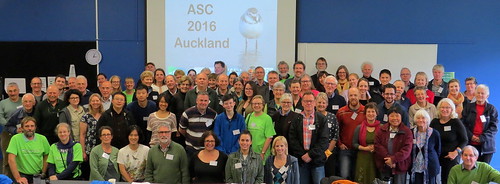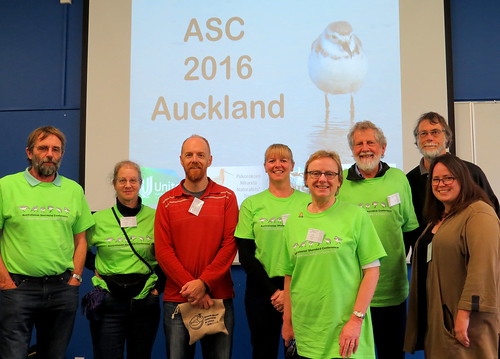Adrian Riegen, P?korokoro-Miranda Naturalists Trust (PMNT)
Every two years the Australasian Wader Study Group (AWSG) holds a conference known as the Australasian Shorebird Conference (ASC). It is usually held in different Australian state capitals and a local group of shorebird people run the conference over a weekend usually in September. It was held in Nelson in 2005, the only time in New Zealand (NZ) until this year when PMNT hosted the conference in Auckland on 1-2 October 2016. Thanks to the wonderful support of Unitec Institute of Technology we were able to hold it at their Carrington Campus. This worked very well with an excellent theatre and two other rooms available to us. Just over 90 people registered for the conference.

ASC delegates © Adrian Riegen
We had a great team of people to organise the conference and field trips, with everyone working on different aspects of the event, so a big thank you to all of them for making the conference very successful, in spite the copious amounts of rain that reminded the 40 or so Australians who attended just why NZ is a green and pleasant waterlogged land.
There were 29 lectures over the two days covering a diverse range of subjects. John Dowding opened the conference with an excellent keynote address about the status of New Zealand’s endemic waders. His address highlighted the issues of habitat loss and the devastating roll the four-legged predators have on our ground-nesting waders.
Peng He who is a PhD student at Fudan University in Shanghai, came to the conference as the Mark Barter Awardee. Mark was a pioneer in the flyway searching almost the entire Chinese coast of the Yellow Sea from the early 1990’s. He worked with Chinese students, encouraging and guiding them. He was a great teacher and was known to many of them as ‘Teacher Mark.’ After his death in 2011 the AWSG set up a fund to support a student, preferably from Asia to attend these conferences. Peng has been studying the feeding behaviour of shorebirds at Yalu Jiang and talked on this subject. Phil Battley put together the program of speakers and a fascinating range of subjects were covered.
Of particular interest were the talks on studies involving light sensitive geolocators. A small devise that records light and dark and from that it is possible to determine approximately where a bird was on any given day. The drawback is that the bird must be caught again to retrieve the geolocators, something most godwits are not keen to experience twice and so there are still plenty of them walking around with geolocators still on their legs. We also heard about the satellite tracking of the Grey Plovers from Australia to Siberia, with some going all the way to Wrangel Island, off the north coast of Siberia. Phil Battley talked about the challenges of using geolocators to determine where Red Knot’s stage on their migration north from NZ. Travelling north as they do around the equinox makes it very difficult to determine their latitude, as day length is almost equal at all latitudes during this period. We need small enough satellite trackers to sort this out.

© ASC organizing team
We heard about a massive LNG project in Queensland and how that is affecting the habitat and shorebirds. Ben Paris talked about New Zealand Dotterel and how management by local communities is helping these vulnerable birds. Pip Wallace talked about the human disturbance and the laws that are supposed to protect wildlife, which are either not powerful enough or more likely not being enforced. It seems that most people with 4 x 4’s, kite surfers, dog owners etc. think they have a right to do whatever they want, wherever they want often to the detriment of wildlife. We should all be putting pressure on local authorities to enforce laws to protect wildlife. Doug Watkins talked about collaboration within the Flyway Partnership and needless to say the PMNT featured strongly, as we have been involved with work along the Flyway since well before it was called that. We were on the ground floor in 1994 when the concept of a network of sites was developed and agreed to at a workshop in Kushiro, Japan. PMNT should be very proud of this record and the way it has tackled big issues without bulking is inspirational to many other organisations. Perhaps it is our small size and independence and a group of open-minded people prepared to try anything that has driven this success.
Birgita Hansen gave us an update on shorebird population estimates, long overdue, as many species are in decline and we have been quoting figures, sometimes decades old.
Maureen Christie from South Australia gave a passion filled talk about how they took on the seaweed harvesting industry and not only won but were instrumental in getting new guidelines and standards for that industry for the whole of South Australia, so that hopefully no one else will have to fight that battle again. We take our hats off to everyone who goes in to battle for protecting the environment; it is very hard especially for people who prefer just being out there with the birds. Janelle Ward spoke about leg cramp that affects some birds when caught and we now have a much better understanding of the problem and are constantly improving the way we catch and handle birds so that this is much less of a problem now.
Finally perhaps the most inspirational talk was by the quietly spoken artist, Amelia Formby from Western Australia, who one day had a sudden thought that she would fly a plane along the same route that the Red-necked Stint travels from Victoria to the north coast of Siberia, where it breeds. She had not flown before, so started taking flying lessons. She decided, as the Red-necked Stint was the smallest wader she should fly the smallest plane and has chosen a small open microlight for the task. There is much to do and she plans to start in 2019. The journey will be done in stages with an aim to finish the whole trip in 2022. The feeling we got was that she will achieve this, so determined is she. A documentary will be made and where possible feeds to social media will be a major part of the venture, which should inspire a whole generation of people not usually tuned into nature. We wish her every success and will offer any support we can.
If you did not attend this conference but wish you had, or did, and would like to attend the next one, then Hobart in 2018 will be the place to be, probably in September of that year.




